Answering the player’s theories with player’s psychology
Player's theories could be linked altogether using psychology (personal assessment) and be used as a game design framework, helping game developers on their early choices of design.


Making a game is mostly answering to a will of giving values, experiences, feelings, stories, etc. from a game developer to a player. But it should also be answering to a player’s needs. Therefore, understanding what please the player in terms of features, of game mechanics, of fun, etc. is a requirement. By combining the use of psychology and player’s theories, game developers are able to do that. And so, create meaningful games for the players.
As producing games become more complex, the market become more competitive and game genres are mixed, game developers sometimes get confused or lost about what could please the the target audience. In the will of helping them, I try to develop a 'framework' linking the understanding of the player and the elements composing a game (story, game mechanics, controls, etc.).
In my journey, I read a lot on one hand about psychology as well as game theories on the other hand. This article is a quick summary of the framework I've developed.
After introducing the psychological method used, I will show for 8 of the most well know player’s theories the relationship they had with it, each illustrated by a scheme with video game examples. And finally, I will talk about how to use it in the case of a game development.
However, I won’t go into the details of each theory but provide a bibliography at the end where to find more information and details about them.
Also do understand than even if talking mostly about video games, this topic covers also classical games (board games, card games, etc.).
The MBTI, base of player’s psychology.
The psychological “method” I use is the MBTI (Myers Briggs Type Indicator). It is “a psychological assessment made to indicate psychological preferences in how people perceive the world around them and make decisions”.
4 dichotomies - preferences - are evaluated:
The Motivation to Act (Extraverted or Introverted);
The method of Gathering Information (Sensing or iNtuition);
The method of Decision Making (Feeling or Thinking);
The Action Mode (Judging or Perceiving);
Sid Meier says “A game is a series of meaningful choices”. Therefore, understanding how the player – or an idealized player, the persona - is making his decisions as he perceived the game world, allows game developers to build an adequate (not custom yet) experience that pleases him. That’s why I chose this method over others even if it’s not the most popular one in the Industries nowadays.
Getting inspired on the MBTI: Demographic Game Design 1
In the book “21st Century Game Design” (1), Chris Bateman and Richard Boon explore “how games can reach wider audiences by appealing to the interests of the core gaming community”, defining what they call the Demographic Game Design 1 (DGD1) about play styles (progression, type of story, social features, etc.) basing it on the use of the dichotomies of Decision Making and Action Mode.
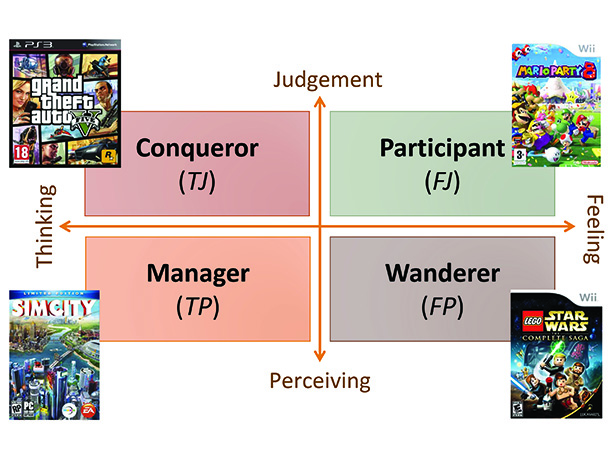
They used also the Berens’s player��’s theory about temperament. Each particular set is related to the method of Gathering Information (Sensing or iNtuition) and Decision Making (Feeling or Thinking). Here is a representation made from their work.
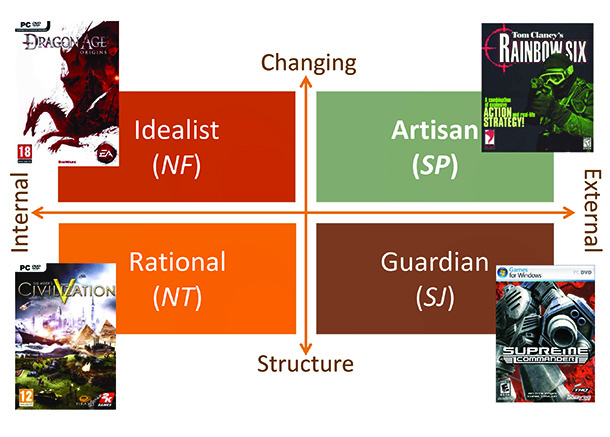
Each temperament could be link to a particular skills set, according to Kersey, that the player use (or seek to use) inside the game.
Applying MBTI to other game theories
Inspired by the work on the DGD1, I studied first the influential game theories, selecting the one that provides directions into the game development:
Caillois' Play & Game differences;
Bartle's Type of Players;
Lazzaro's 4 keys of fun;
Stewart's GNS+ & MDA+;
Leblanc's Fun;
Chou's Octolysis;
I focused then on finding links between each theory and their categories. For example, the Bartle's Killer could be associated to Lazzaro's Hard and People Fun. Or that Leclanc's Submission could be associated to Stewarts's Gamism. You could see an example below.
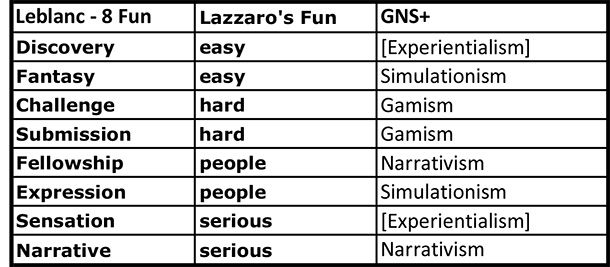
After that, I identified for each game theory and categories, which dichotomy or couple of dichotomies could be applied. And confirming or altering the links I've established before. I ended with something like this...

Finally, I run a couple of tests (more than 200) to check the validity of the dichotomies selected per game theories, using online MBTI tests like this one. Iterating on the 'wrong' associations, validating the good ones.
Here are the associations I've come up with.
Caillois’ Play & Game differences
The first one to be analysed was Roger Caillois’ 4 types of play (2).
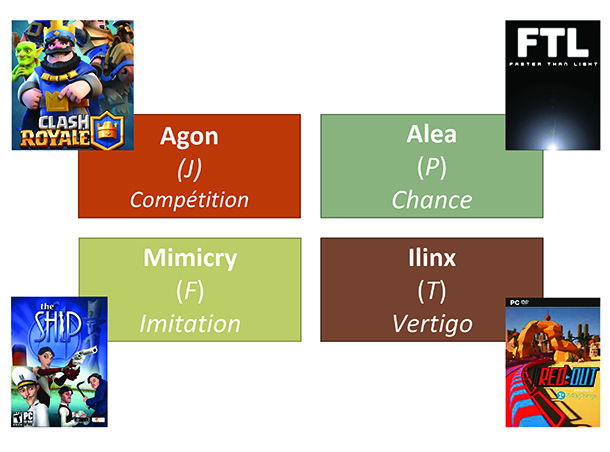
This player’s theory is, as we can see, again about Decision Making and Action Mode.
Bartle’s type of players (3)
Bartle’s 4 types of players was the second theory to be analysed through the scope of the MBTI. Richard Bartle identified the type of interactions the player is seeking in the game.

This player’s theory is focused on the method of Gathering the Information as well as on the Decision Making and the Action Mode.
Lazzaro’s 4 keys to Fun (4)
The third player’s theory is the one from Nicole Lazzaro on the 4 types of game elements that drive the Fun. In fact, players play to feel a particular fun, sometimes from the game itself (challenges or story) or related to it (knowledge or participation).

GNS+ (5)
The also called threefold model was the fourth one. Ron Edwards defines 3 categories of intentions and/or feelings that drive the player through the game, the GNS. Bart Stewart added later a 4th one, the “Experientalism” one.
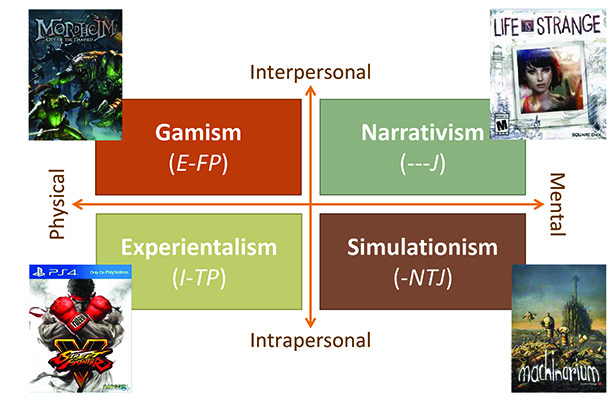
MDA+ (6)
The fifth one is based on the MDA model from by Hunicke, LeBlanc and Zubek (6)(7), on top of which Bart Stewart also added a 4th dimension, the “Kinetic” one. The theory is about which game components are important to the player: are they art or feelings? the controls? The system itself?

As for Bartle’s types of player, this theory is focused on the method of Gathering the Information, the Decision Making and the Action Mode.
Leblanc’s Fun (8)
Following the work of Lazzaro on the Fun in games, Marc Leblanc targets more precisely the game or storytelling elements inside the game that keep the player into it.
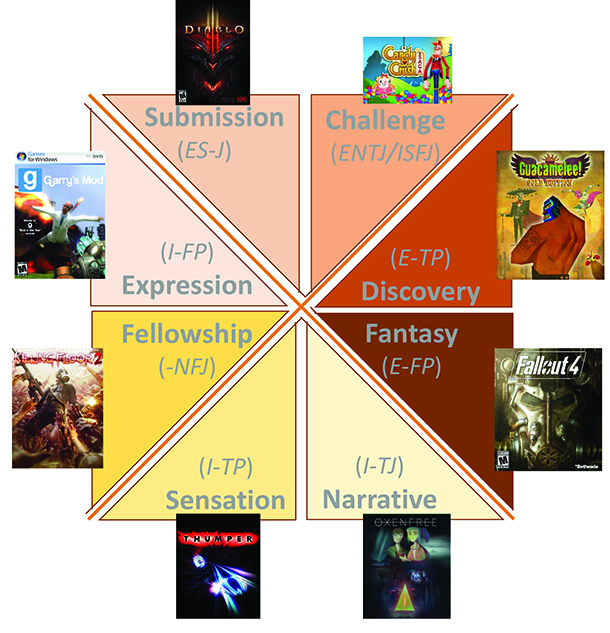
Yu-kai Chou’s Octalysis (9)
The latest addition to the theories analysed is the gamification framework made by It distinguishes 8 cores – sensations – that motivates players to act. Those cores are related to the Motivation to Act (Extraverted or Introverted) and the method of Gathering Information (Sensing or iNtuition).
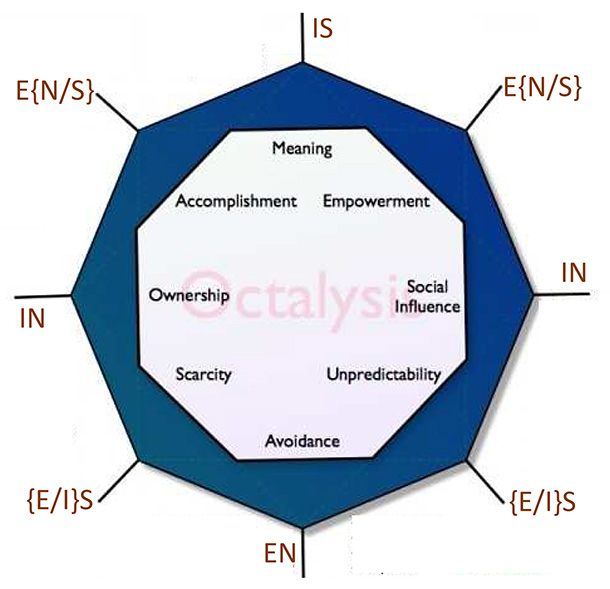
Furthermore, Yu-kai Chou makes a distinction between the left and right brain – emotional vs logical-, illustrated on the scheme by the vertical dichotomy about the method of Decision Making (Feeling or Thinking). To be noticed that for only both “Meaning” and “Avoidance” cores, the dichotomy is uncertain (depending on the ingame situation).
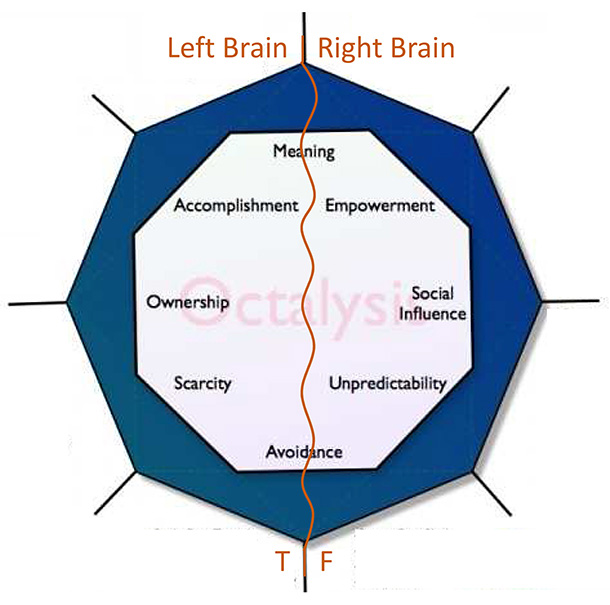
He also talks about the white and black hats gamification (or game mechanics as we can relate): positive or negative motivations for ‘action’. They are illustrated on the scheme by the horizontal dichotomy about the Action Mode (Judging or Perceiving). Also to be noticed here that for only both “Ownership” and “Social Pressure” cores, the dichotomy is uncertain (depending on the ingame situation).
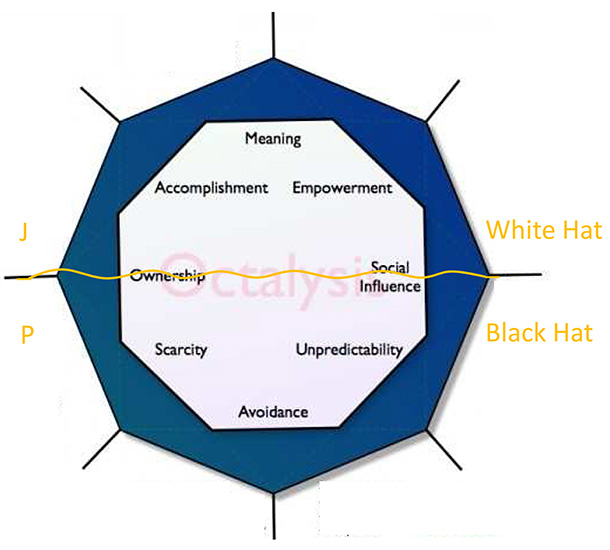
The Persona, a useful idealised player
Video game market is wide and evolving quickly. Even by targeting niches, it’s difficult to understand their players fully. And even when the game developers are themselves players from those niches. Also, during the game development, teams become less and less objective about their works and substitute their will to the player’s will.
Therefore, as already done is several big companies and not only in the marketing field, the use of a persona is important for teams to maintain and stick to the player’s vision of the game. A persona is an idealist but credible imaginary player, defined by demographics information, habits of play, like and dislike about games, hobbies, way of life, etc.
The persona is a virtual entity to who the game developers turn to for guidance. Substituting nameless players to a unique ‘tangible’ persona make decisions quicker to take about the game, like “Does Georges like customisation of his avatar? Does he want co-operative team play?”, as they have a direct impact on someone.
This is why every game developer in pre-production should do one.
Use of the player’s theories with Persona’s MBTI
Understanding the player is a key to create successful - maybe not commercially but at least critically - games. Building a game that provides the requested features, game mechanics, game elements and fun leads to it.
To achieve that, game developers should use their persona in order to conduct a MBTI evaluation. A link the results to the player’s theories as follow, by creating a player’s profile.
The example of player’s profile below is taken from my own automated evaluation tool from MBTI evaluation to the various player's theories seen.

The evaluated player’s profile creates a list of game elements to be implemented, like a heuristic. Or a base for a game to improve on, by selecting the most important elements requested by the persona / player.
But as we can see in the scheme below, a player is not a uni-dimensional individual. He is neither or no only one aspect of a player’s theory. It’s more about this aspect suits me better first, and then the other. That’s why it’s important not only to consider the dichotomies themselves but also the percentages evaluated. The dot icons illustrating the priority.

As debated with Nicole Lazzaro during the Game Summit in Montpellier on November 2016, game developers should focus on the 2 most important player’s tendencies for each player’s theories (or 3 in case of Leblanc’s Fun and Chou’s Octalysis).
To conclude
Using both persona’s psychology and player’s theories is an easy and quick way either to create or to validate the main game elements for game developers. It should be done alongside the creative processes and methods during the pre-production time.
However, it just an entry point to the game design as it requires work to improve features and game mechanics to make them unique to the game. Also, players tend to evolve during the play and so on, their player’s profile (as demonstrated by Andrzej Marczewski in his articles (10)). Thus, the game mechanics and features should follow the player’s journey by being ‘unlocked’ at the right time.
Therefore, a game designer is a must have in the team for every game production.
Bibliography
“21st Century Game Design” by Chris Bateman and Richard Boon;
“Les jeux et les hommes” by Roger Caillois;
“Video Game Principles & Practices” by Michael Salmond;
The 4 keys to fun by Nicole Lazzaro [LINK]
“Personality and Play Styles: A Unified Model” from Bart Stewart [LINK];
“MDA: A Formal Approach to Game Design and Game Research” by Robin Hunicke, Marc LeBlanc and Robert Zubek [LINK];
“100 Principles of Game Design” (D.A p.30);
“The Art of Game Design” by Jesse Schell;
“Actionable Gamification - Beyond Points, Badges, and Leader boards” by Yu-kai Chou [website];
Andrzej Marczewski’s blog;
Also to be mentioned:
“Beyond Game Design” by Chris Bateman;
“Game Usability” by Katherine Isbister and Noah Schaffer;
“David Perry on Game Design” by David Perry and Rusel DeMaria;
A majority of schemes / pictures are taken from my French talk at Push-It [LINK HERE].
You cand find more articles on my blog both in French or in English: HERE
Read more about:
BlogsAbout the Author
You May Also Like









